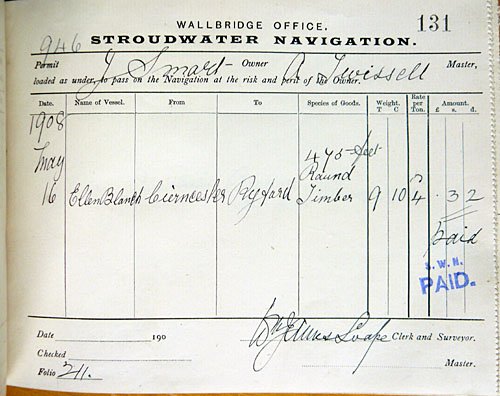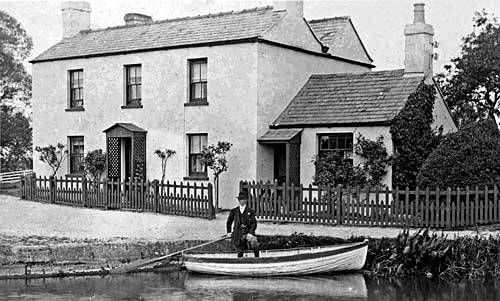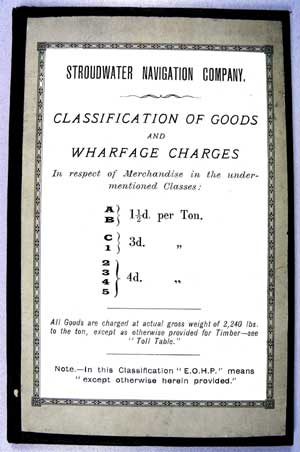Toll payments could be made at Wallbridge or Framilode (later Saul Junction). High tonnage rates were charged in the early days, but these had to be reduced in stages to meet increasing competition from the railways.


When joining the canal, the captain of a vessel was expected to show to a toll clerk a written note saying what he was carrying, where it was from and where it was being taken to. The procedures for collecting tolls and recording the money collected developeded over time. In later years, details were written on a ticket given to the captain, and the image shows how they were also written on a counterfoil kept by the clerk.
The toll could be paid on entry or after the cargo had been signed for by the recipient, or it could be paid later by the vessel owner if he had an account. After the toll was paid, the details were also entered into a tonnage register as a permanent record of the cargo and the money paid.
In the early days, charges were also made for wharfage and for use of any crane, but in later years wharfage charges were not normally claimed.


In the early days, all vessels from the west reported to a toll clerk at Framilode. After the opening of the Gloucester & Berkeley Canal in 1827, the Stroudwater Company made use of the services of that company's clerk at Saul Junction to monitor vessels joining the canal there. In 1869, this became the sole check on vessels entering from the west.
In later years, vessels delivering to Dudbridge and places further east were expected to pay their toll and clear their paperwork with the clerk at the Wallbridge office. Vessels not going beyond Ebley cleared out at Framilode (or later Saul Junction). Wharfingers and lock keepers were also expected to make occasional checks and to report anything irregular.
The tonnage rate per ton payable depended on the nature of the cargo and the distance travelled along the canal. The maximum rates laid down in the original 1730 Act of Parliament were charged initially, but following a proposal to build a tramroad along the route in 1825, the Company was forced to reduce the rates, and this was enough to stop the railway going ahead. Further reductions were needed in later years to meet competition from main line and local railways, and there were lengthy negotiations with the Thames & Severn Company as to how these would be implemented. By 1880, rates were less than one third of what they had been in the early days. Traders could also negotiate drawbacks giving them a lump sum return payment if they carried more than an agreed quantity of a cargo in a certain period.


To help canal companies compete with railways, the Government organised a clearer system of tolls under the Railway & Canal Traffic Act 1888. The image shows the booklet, issued nationally, grouping all types of merchandise into classes, with the Stroudwater Company's agreed wharfage charges on the cover. The Company's agreed maximum tonnage rates for each class were advertised separately, and both regulations came into force in 1894.
During the First World War, most canals came under Government control and were given a subsidy, but apparently the traffic on the Stroudwater Canal was not considered of sufficient significance to be included initially. By 1919, however, as wages increased but rates remained fixed, the Stroudwater Company was allowed to join the scheme to benefit from the subsidy rather than go out of business.
Information about Toll Collection and Rates during the operational period up to 1941 can be found by searching the Minute Book and Letter Book pages in the Archives section of this website. Additionally, a list of relevant documents that can be consulted at Gloucestershire Archives can be found in the Subject Listings page under the heading Toll Collection and Rates.
Found in the Archive
When Thomas Young arrived at Saul Junction in January 1852, he declared his cargo of 24 tons of salt, but as the boat reached Dudbridge, it filled with water and sank. He still had to take his ticket to the office at Wallbridge, but when he explained what had happened, he was excused paying any toll and the cargo was recorded in the Canal Company’s books as ‘unsaleable’. (D1180/4/23)